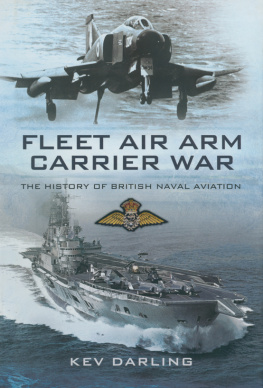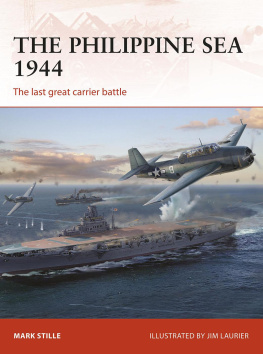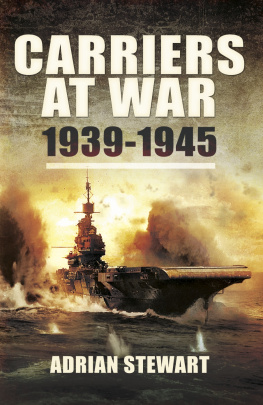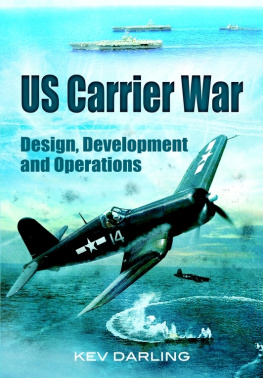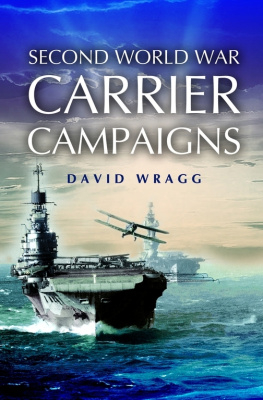
F4F fighters of VF-6 being rearmed on the deck of USS Enterprise early in 1942.
Copyright The Estate of J D Brown 2009
Editors Foreword David Hobbs 2009
First published in Great Britain in 2009 by
Seaforth Publishing
An imprint of Pen & Sword Books Ltd
47 Church Street, Barnsley
S Yorkshire S70 2AS
www.seaforthpublishing.com
Email
British Library Cataloguing in Publication Data
A CIP data record for this book is available from the British Library
ISBN 978-1-84832-042-0
EPUB ISBN: 978-1-78346-930-7
PRC ISBN: 978-1-78346-697-9
All rights reserved. No part of this publication may be reproduced or transmitted in any
form or by any means, electronic or mechanical, including photocopying, recording, or
any information storage and retrieval system, without prior permission in writing of both
the copyright owner and the above publisher.
The right of J D Brown to be identified as the author of this work has been asserted in
accordance with the Copyright, Designs and Patents Act 1988
Typeset and designed by Ian Hughes
Printed and bound in China

CONTENTS
Volume One:
The Royal Navy, September 1939 September 1945
Volume Two:
The Pacific Navies, December 1941 February 1943
Volume Three:
The Pacific Navies, February 1943 September 1945

EDITORS FOREWORD
My friend and mentor David Brown served as an observer in the Royal Navys Fleet Air Arm for a decade from the late 1950s into the 1960s and flew in Sea Venoms, Sea Vixens and Buccaneers. His love for the Service and its fascinating history led him to research data about its past so that when he left the Navy it seemed natural for him to join the Naval Historical Branch in London as a historian. He became Head of the Branch and served in that capacity for over twenty-five years, earning an international reputation as the foremost expert of his generation on the history of naval aviation. He wrote extensively about the subject with works including the definitive history of the Supermarine Seafire, the Spitfire that went to sea and carrier-borne fighters. To the Naval Staff he was History Brown, the man who could answer any question on the Royal Navys recent past without having to resort to reference books. By his own admission, though, he was less expert on the sailing navy of the wood and canvas era. He had a natural talent for spotting a love of history in others and encouraging them to write.
Throughout his life he continued to research into the operational activities of the three principal air-minded navies, those of Great Britain, the United States and Japan, in World War II. The material he gathered was transcribed by hand into a series of large notebooks and some of it was used in two separate works that he published on the Royal Navys carrier operations and those of the Pacific Navies prior to 1943. He continued his research, clearly a labour of love, both on the activities of the Pacific Navies after 1943 and adding material to his earlier studies with a view to publishing the full history of wartime carrier operations but his untimely death in 2001 prevented him from completing the work.
When Rob Gardiner of Seaforth Publishing suggested republishing the earlier work with the unpublished later material on the Pacific War, I was delighted to be able to help. On studying Davids large archive of notes, I found that it was possible not only to use them to finish the work using his own words and data for the period from the Marianas Turkey-Shoot onwards, but to add more detail to improve on the works that had been published previously. Thus material that had appeared as two separate volumes together with notes for the third, unpublished, volume have evolved, been expanded and brought together in a significant new book. It has also proved possible to add more photographs, many of them previously unpublished, from collections to which David did not have access, in addition to a selection of original pictures from his own archive. They have been spread throughout the work rather than concentrated in a single picture section in the middle and modern printing techniques have allowed reproduction with much greater clarity. The finished work gives a clear view of every carrier operation in World War II for the first time and accurately lists ships, air squadrons, locations and activities, highlighting both the strategic and tactical value of naval aviation in the first war in which it played a major part. Seaforth Publishing is to be congratulated for spotting the potential latent in the expanded volume and for publishing it.
I am grateful to Davids wife Margaret for making his notes available and, by transcribing them into this comprehensive work I am delighted to have contributed, in a small way, to the publication of the finished volume which he always intended to be the end-product of his research. The incorporation of all the material under one cover and the addition of many more photographs have produced a book that is both informative and attractive which will, I am sure, appeal to a wide variety of readers. David would have been both pleased and proud of the finished article.
The ultimate success of the British and American carrier fleets owed much to the inherent flexibility of carrier-borne aircraft and to the capability and skill of many thousands of un-named sailors in addition to those few who are named in this work. The Imperial Japanese Navy also contributed much to the development of naval aviation as we now know it. David Browns work is a worthy tribute to the ships and aircraft of the three fleets and the men who manned them.
David Hobbs
Twyford, Dorset
January 2009


INTRODUCTION
In less than six years the Fleet Air Arm (FAA) of the Royal Navy grew from a small striking force, limited in numbers, manpower and material, into a powerful strategic weapon which was as large as the prewar Royal Air Force (RAF) in terms of effective front-line aircraft. Conceived and initially employed as an extension of the big guns of the fleet, naval aviation was developed to the point where the aircraft carrier became the vital ship in any formation, offensive or defensive, with the battleship providing anti-aircraft protection with its considerable medium and close-range batteries.
The roles of the carrier aircraft were those traditionally fulfilled by the Royal Navy, only the method and time-factor differing. The primary tasks were the destruction of enemy fleets; offensive and defensive patrol, search, and reconnaissance; offensive operations to seek out and destroy enemy shipping in coastal waters and harbours, and to strike at shore installations; and the support and protection of seaborne landings.
The list of major warships sunk or seriously damaged by the naval aircraft is impressive, although the caution with which the German and Italian navies employed their surface fleets when opposed by the Home and Mediterranean Fleets led to fewer encounters than might have been expected. The battleships Littorio, Vittorio Veneto, Caio Duilio, Richelieu and Dunkerque were all torpedoed and put out of action by Fairey Swordfish and Albacore aircraft between June 1940 and May 1941, while




